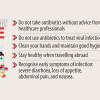Revenge of the Bugs

Antibiotic resistance is the new bacterial normal. About a hundred years ago with the discovery of penicillin, the antibiotic revolution commenced the era of modern medicine. Yet cloaked in penicillin's serendipitous beginning were signs of a catastrophe. "It's Newton meets Darwin," according to Michael Gilmore, Professor of Ophthalmology at Harvard Medical School and director of the Harvard-wide Program on Antibiotic Resistance. "For every biological action, there's an equal and opposite reaction."
Many think we face the risks of returning to the 19th century when germs ruled over humans. Physicians may run out of treatment options altogether. Regular operations could become deadly minus the ability to kill harmful bacteria. Minor infections could become life-threatening conditions. Pneumonia could be more and more difficult to treat.
It's already causing collateral damage. About 50,000 lives are lost annually to antibiotic-resistant infections in the US and Europe alone. Globally as many as 700,000 people die of drug resistance in illnesses caused by bacterial infections. If the resistance continues at the current rate, 10 million people will die each year by 2050.
Drug resistance is common in all microorganisms but resistance works differently in Bacteria: their resistance can be transferred. They can exchange small, circular pieces of DNA called Plasmids, which carry genes for resistance. Most genetic material is transmitted only from parent to offspring, but plasmids can be transferred from neighbour to neighbour. This unique ability makes bacteria an even greater threat.
This defiance has followed hard on the heels of each miracle antibiotic. For example, penicillin-resistant staphylococcus was already being seen in labs in 1940, a few years before mass-produced penicillin was introduced. Tetracycline, a most important medication needed in a basic health care system, was introduced in 1950, and resistant shigella was identified in the same decade. "It is a classic example of use and adaptation—use by humans for their cure and adaptation by bacteria for their survival. It is the true biological warfare," says Dr Zia Uddin Ahmed, former Professor of Microbiology at Jahangirnagar University and author of Genetics of Antibiotic Resistance (2007).
We have only ourselves to blame. An astonishingly high percentage of antibiotic use in humans is estimated to be unnecessary. Antibiotics are often prescribed needlessly for ailments like the common cold and the flu, which are not even caused by bacteria, but by viruses. For instance, in the United States, antibiotics are prescribed 70 percent of the time even though medical guidelines state that they are never needed for acute bronchitis. According to a 2014 study by Dhaka Shishu Hospital, 72 percent of the children admitted at the hospital were given at least one antibiotic, while 51 percent received several.
Over-prescription has complex roots. Patients are often confused about how long symptoms last, even though a couple of weeks are normal for a cold, a month for a cough. Doctors, on the other hand, may prescribe antibiotics in hope of avoiding confrontation with a patient. "In our country, there is a serious lack of awareness among doctors and patients about this issue. They prescribe antibiotics without any regulation. And antibiotics are sold over the counter indiscriminately," Dr. Ahmed says.
The practice of over-prescription of antibiotics benefits both pharmaceutical and agricultural industries. The bulk of the antibiotic use today takes place on livestock. How does that pose a risk to humans? There are several ways. The genes that produce resistance to antibiotics can be easily transferred between bacterial species. Humans can come in contact with them through consumption of undercooked meat or other food products. Manure from antibiotics fed animals is commonly used as fertilisers. Farmers and workers in slaughterhouses may also come in contact with the bacteria.
Taxing the inappropriate use of antibiotics in agriculture and then using the proceeds to subsidise vaccination can be a good start. The strategy has worked in Denmark which introduced targets to limit the use of antibiotics and, contrary to the agricultural lobbyists' warnings, Danish food productivity increased.
The underlying issue is a "classic market failure problem" that requires intervention from governments in the form of regulation, subsidy and taxation. On the supply side, pharmaceutical companies should be incentivised to commit resources for new antimicrobial drugs. Better, faster diagnostic tools should be developed for physicians. And practitioners should be prohibited from prescribing antibiotics to patients unless they have carried out a test that shows the drug is being targeted correctly.
Experts argue rational use of antibiotics is the answer. But what if practitioners do not have adequate knowledge of the mechanism of functions of antibiotics at the molecular level? It has to be part of the curricula at universities and medical colleges. And we need to communicate to seven billion humans around the world that yes, antibiotics are fantastic but only if correctly used.
Nature developed resistance in the bacterium perhaps to teach scientists a little humility.
The writer is a member of the editorial team at The Daily Star.

 For all latest news, follow The Daily Star's Google News channel.
For all latest news, follow The Daily Star's Google News channel. 




Comments